Transcend SSD370 (128GB, 256GB & 512GB) Review
by Kristian Vättö on January 27, 2015 8:00 AM EST- Posted in
- Storage
- SSDs
- Transcend
- Silicon Motion
- SM2246EN
Random Read/Write Speed
The four corners of SSD performance are as follows: random read, random write, sequential read and sequential write speed. Random accesses are generally small in size, while sequential accesses tend to be larger and thus we have the four Iometer tests we use in all of our reviews.
Our first test writes 4KB in a completely random pattern over an 8GB space of the drive to simulate the sort of random access that you'd see on an OS drive (even this is more stressful than a normal desktop user would see). We perform three concurrent IOs and run the test for 3 minutes. The results reported are in average MB/s over the entire time.
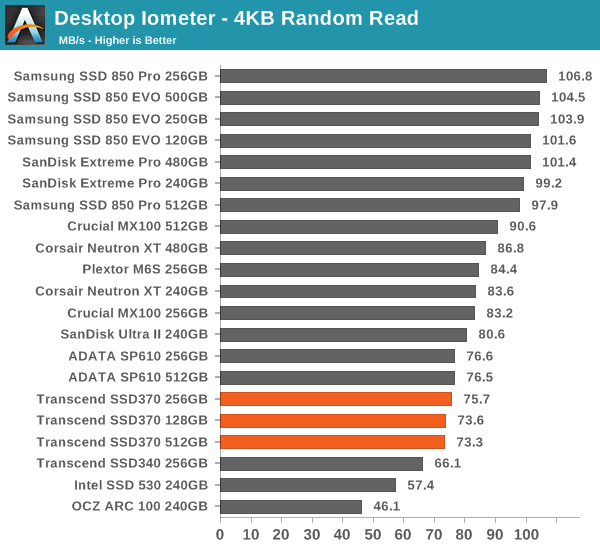
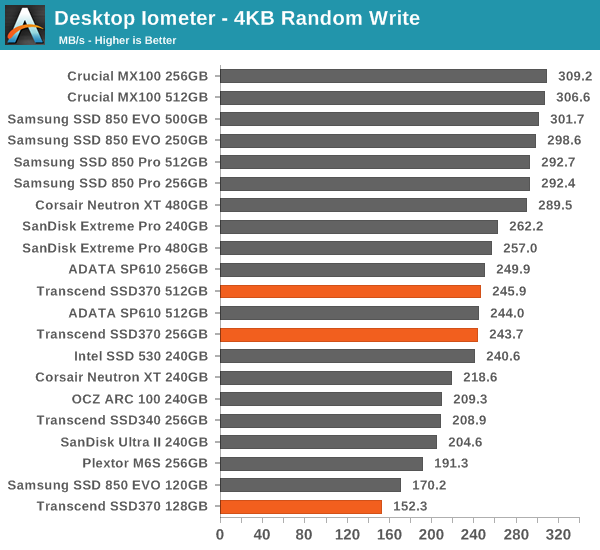
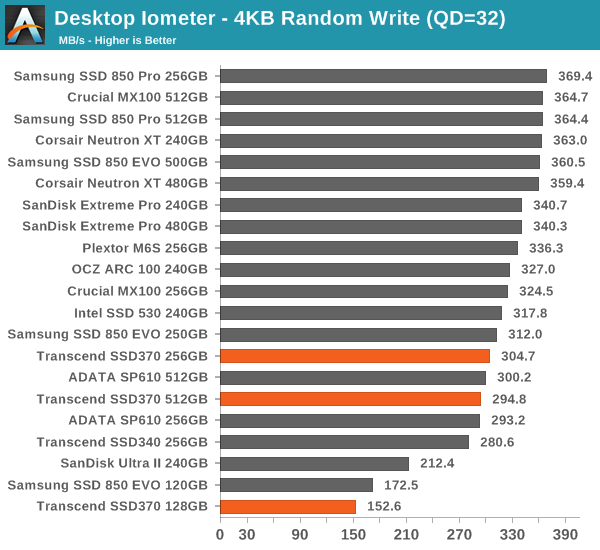
Random performance is a match with the SP610 too. The SSD370 isn't the fastest drive on earth, but its performance is decent given its value focus.
Sequential Read/Write Speed
To measure sequential performance we run a 1 minute long 128KB sequential test over the entire span of the drive at a queue depth of 1. The results reported are in average MB/s over the entire test length.
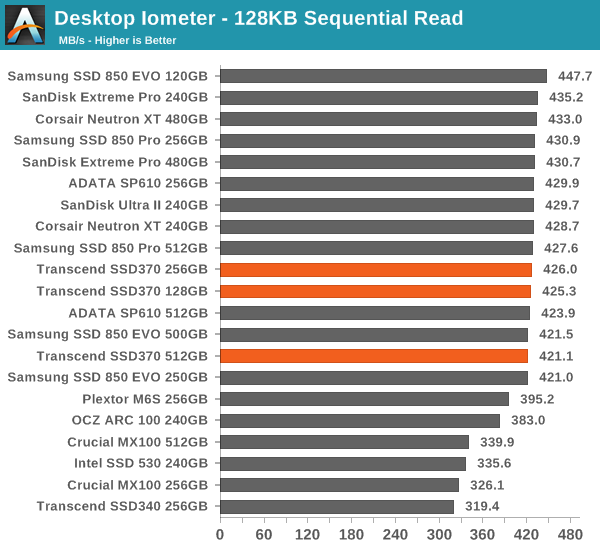
No surprises in sequential performance either. At 128GB and 256GB the write speeds are limited due to lesser parallelism, but in both cases the performance is fairly normal to drives with 128Gbit NAND.
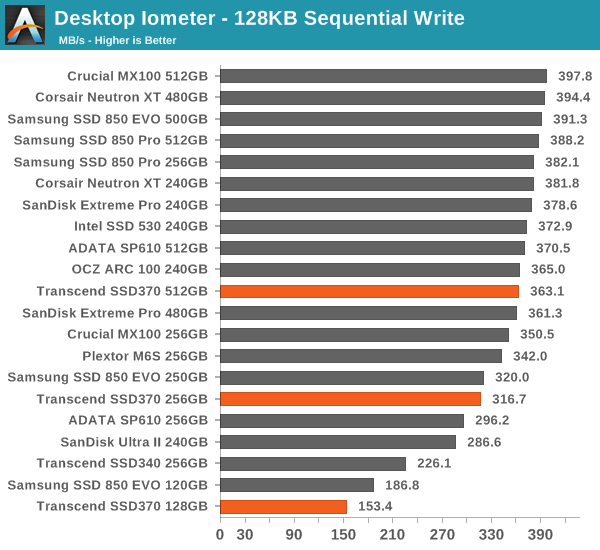
AS-SSD Incompressible Sequential Read/Write Performance
The AS-SSD sequential benchmark uses incompressible data for all of its transfers. The result is a pretty big reduction in sequential write speed on SandForce based controllers, but most other controllers are unaffected.
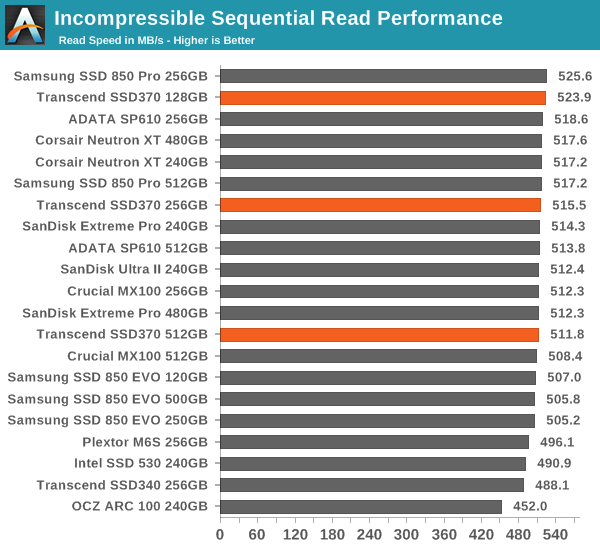
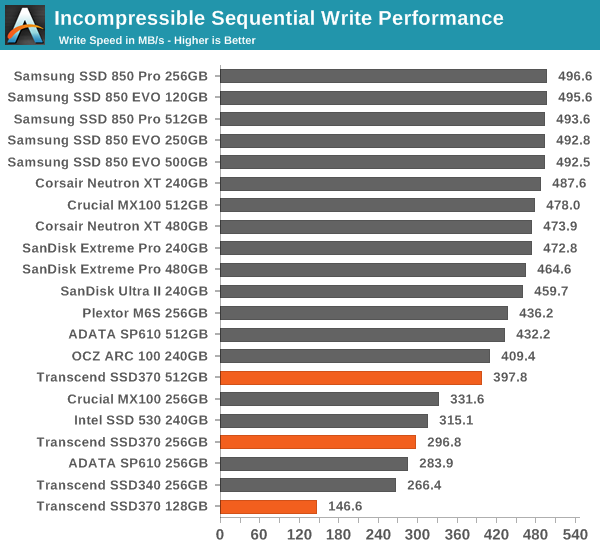










44 Comments
View All Comments
Hulk - Tuesday, January 27, 2015 - link
Perhaps I missed it but no mention/testing of endurance? All I see are manufacturer quoted numbers in the table.DanNeely - Tuesday, January 27, 2015 - link
Barring catastrophic failures, endurance testing a drive to destruction takes many months. Tech Report started torturing a set of 256GB drives in late 2013; as of last month 2 of the 6 drives were still running.http://techreport.com/review/27436/the-ssd-enduran...
Hulk - Tuesday, January 27, 2015 - link
I guess you don't read Anandtech much. Generally they run down the drive enough to move the counter down a few percent, then make a good estimate of endurance based on those numbers. I think it's very interesting and pretty much only Anandtech does it. Or used to do it.extide - Tuesday, January 27, 2015 - link
Maybe it's you that doesn't read AT that much ;) (Haha, I had to)They typically will only do that when they are testing drives with a new type of NAND that we haven't seen yet before, or testing some weird scenario, or something like that. Micron 20nm NAND is a well known entity at this point, and even though they are using custom firmware on this controller, it's performance and behavior seems very similar to the stock SMI firmware -- so basically there is nothing remarkable here. I am sure the endurance will be similar to most other drives with this type of NAND.
Kristian Vättö - Tuesday, January 27, 2015 - link
Right on the spot. I only do endurance testing with new NAND generations that we haven't seen before to figure out the P/E cycle rating. It takes days, possibly weeks, so there is no point in testing that with every drive. After all, the manufacturers' ratings still matter because once those are reached the warranty will be voided anyway, so my endurance tests aim to tell more about the NAND than the drive itself.Hulk - Tuesday, January 27, 2015 - link
Okay makes sense.I can admit when I'm wrong.
Hulk - Tuesday, January 27, 2015 - link
But wait. Does it take days or weeks to run down the counter 1 or 2 percent? That's all you need to get an estimate on actual endurance right?And isn't there variation in the NAND that each manufacturer buys for each line of drives? I'm talking about the binning and how endurance can vary for the same process.
Kristian Vättö - Tuesday, January 27, 2015 - link
The problem is finding the exact spot where the counter changes by 1 percent, so it usually takes at least a few percent worth of cycling to find that. Generally it takes a couple of days for client drives, but even then that time is away from testing other drives.You are correct that not every die is equal, but the P/E cycle rating is usually conservative to guarantee that all SSD-grade dies comply that spec. With binning and parameter trimming it's possible to get much more out of the dies though.
Hulk - Tuesday, January 27, 2015 - link
Wow. Thanks for the specific reply.Souka - Wednesday, January 28, 2015 - link
Just thought to share:I've fried 3 brand new SSDs in my torrent box over the past year. Granted two were 64GB, one 120GB, and they were pretty meh to begin with performance wise.
I knew the SSD wouldn't last, but didn't expect it to fail that quickly. Currently have an OLD 64GB Intel SLC (X25 I think) in for past few months...no issue yet.